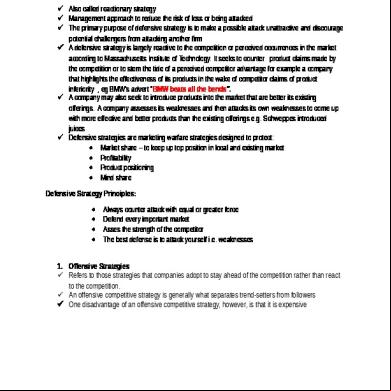Defensive Strategies 3o3l6i
This document was ed by and they confirmed that they have the permission to share it. If you are author or own the copyright of this book, please report to us by using this report form. Report 3b7i
Overview 3e4r5l
& View Defensive Strategies as PDF for free.
More details w3441
- Words: 1,199
- Pages: 4
Defensive Strategies Also called reactionary strategy Management approach to reduce the risk of loss or being attacked The primary purpose of defensive strategy is to make a possible attack unattractive and discourage potential challengers from attacking another firm A defensive strategy is largely reactive to the competition or perceived occurrences in the market according to Massachusetts Institute of Technology. It seeks to counter product claims made by the competition or to stem the tide of a perceived competitor advantage for example a company that highlights the effectiveness of its products in the wake of competitor claims of product inferiority , eg BMW’s advert “BMW beats all the bends”. A company may also seek to introduce products into the market that are better its existing offerings. A company assesses its weaknesses and then attacks its own weaknesses to come up with more effective and better products than the existing offerings e.g. Schweppes introduced juices Defensive strategies are marketing warfare strategies designed to protect: Market share – to keep up top position in local and existing market Profitability Product positioning Mind share Defensive Strategy Principles:
Always counter attack with equal or greater force Defend every important market Asses the strength of the competitor The best defense is to attack yourself i.e. weaknesses
1. Offensive Strategies Refers to those strategies that companies adopt to stay ahead of the competition rather than react to the competition. An offensive competitive strategy is generally what separates trend-setters from followers One disadvantage of an offensive competitive strategy, however, is that it is expensive
Approaches
Offensive attacks may or may not be aimed at particular rivals; they are motivated by a desire to win sales and market share at the expense of other companies in the industry. 2. There are six basic types of strategic offensives: a. Initiatives to match or exceed competitor strengths b. Initiatives to capitalize on competitor weaknesses c. Simultaneous initiatives on many fronts d. End-run offensives e. Guerilla offensives f.
Preemptive strikes
3. Initiatives to Match or Exceed Competitor Strengths: The first is when the company has no choice but to try to cut away at a strong rival’s competitive advantage. The second is when it is possible to gain profitable market share at the expense of rivals despite whatever resource strengths and capabilities they have. Attacking a powerful rival’s strengths may be necessary when the rival has either a superior product offering or superior organizational resources and capabilities. The classic avenue for attacking a strong rival is to offer an equally good product at a lower price. Other strategic options for attacking a competitor’s strengths include going into next-generation technologies to make the rival’s products obsolete, adding features that a competitor’s product doesn’t have. Eg CBZ’s Funeral Cash Plan to match First Mutual’s Cash Plan 4. Initiatives to Capitalize on Competitor Weaknesses: Initiatives that exploit competitor weaknesses stand a better chance of succeeding than do those that challenge competitor strengths. Options for attacking the competitive weaknesses of rivals include: (1) going after the customers of those rivals whose products lag on quality, features, or product performance, (2) making special sales pitches to the customers of those rivals who provide subpar customer service, (3) trying to win customers away from rivals with weak brand recognition, (4) emphasizing sales to buyers in geographic regions where a rival has a weak market share or is exerting less competitive effort, and (5) paying special attention to buyer segments that a rival is neglecting or is weakly equipped to serve. 5. Simultaneous Initiatives on Many Fronts: Multifaceted offensives have their best chance of success when a challenger not only comes up with an especially attractive product or service but also has the brand awareness and distribution clout to get buyers’ attention. Eg Econet 6. End-Run Offensives: to maneuver around competitors, capture unoccupied or less congested market territory, and change the rules of the competitive game in the aggressor’s favor. Examples include: (1) introducing new products that redefine the market and the of competition, (2) launching initiatives to build strong positions in geographic areas where close rivals have little or no market presence, (3) trying to create new segments by introducing products with different attributes and performance features to better meet the needs of selected buyers, and (4) leapfrogging into next-generation technologies to supplant existing technologies, products, and/or services.
7. Guerrilla Offensives: Guerrilla offensives are particularly well suited to small challengers who have neither the resources nor the market visibility to mount a full-fledged attack on industry leaders. Guerrilla offensives can involve making scattered random raids on the leader’s customers, surprising key rivals with sporadic but intense bursts of promotional activity, or undertaking special campaigns to attract buyers away from rivals plagued with a strike or problems meeting delivery schedules. Eg Nigerian Shops 8. Preemptive Strikes: Preemptive strategies involve moving first to secure an advantageous position that rivals are foreclosed or discouraged from duplicating. There are several ways a firm can bolster its competitive capabilities with preemptive moves: (1) securing exclusive or dominant access to the best distributors in a particular geographic region or country, (2) moving to obtain a more favorable site along a heavily traveled thoroughfare, and (3) tying up the most reliable, highquality suppliers via partnerships, long-term contracts, or acquisitions . Delta bought bottling plant , Delta’s distribution channels in rural areas
Defensive Approaches Defensive strategies usually do not enhance a firm’s competitive advantage, they can definitely help fortify its competitive position, protect its most valuable resources and capabilities from imitation, and defend whatever competitive advantage it might have. Eg Ecoweb/ ZOL/ Liquid Merger Defensive strategies can take either of two forms: actions to block challengers and signaling the likelihood of strong retaliation. CORE CONCEPT: It is just as important to discern when to fortify a company’s present market position with defensive actions as it is to seize the initiative and launch strategic offensives. A. Blocking the Avenues Open to Challengers 1. The most frequently employed approach to defending a company’s present position involves actions that restrict a challengers options for initiating competitive attack. Eg Econet was g on agreement with African Sun and African Sun demanded that they have a lead period over RTG 2. There are any number of obstacles that can be put in the path of would-be challengers. CORE CONCEPT: There are many ways to throw obstacles in the path of challengers. B. Signaling Challengers that Retaliation is Likely 1. The goal of signaling challengers that strong retaliation is likely in the event of an attack is either to dissuade challengers from attacking at all or to divert them to less threatening options. Either goal can be achieved by letting challengers know the battle will cost more than it is worth. 2. Would-be challengers can be signaled by: a. Publicly announcing management’s commitment to maintain the firm’s present market share b. Publicly committing the company to match competitors’ or prices c. Maintaining a war chest of cash and marketable securities
d. Making an occasional strong counter response to the moves of weak competitors to enhance the firm’s image as a tough defender
Always counter attack with equal or greater force Defend every important market Asses the strength of the competitor The best defense is to attack yourself i.e. weaknesses
1. Offensive Strategies Refers to those strategies that companies adopt to stay ahead of the competition rather than react to the competition. An offensive competitive strategy is generally what separates trend-setters from followers One disadvantage of an offensive competitive strategy, however, is that it is expensive
Approaches
Offensive attacks may or may not be aimed at particular rivals; they are motivated by a desire to win sales and market share at the expense of other companies in the industry. 2. There are six basic types of strategic offensives: a. Initiatives to match or exceed competitor strengths b. Initiatives to capitalize on competitor weaknesses c. Simultaneous initiatives on many fronts d. End-run offensives e. Guerilla offensives f.
Preemptive strikes
3. Initiatives to Match or Exceed Competitor Strengths: The first is when the company has no choice but to try to cut away at a strong rival’s competitive advantage. The second is when it is possible to gain profitable market share at the expense of rivals despite whatever resource strengths and capabilities they have. Attacking a powerful rival’s strengths may be necessary when the rival has either a superior product offering or superior organizational resources and capabilities. The classic avenue for attacking a strong rival is to offer an equally good product at a lower price. Other strategic options for attacking a competitor’s strengths include going into next-generation technologies to make the rival’s products obsolete, adding features that a competitor’s product doesn’t have. Eg CBZ’s Funeral Cash Plan to match First Mutual’s Cash Plan 4. Initiatives to Capitalize on Competitor Weaknesses: Initiatives that exploit competitor weaknesses stand a better chance of succeeding than do those that challenge competitor strengths. Options for attacking the competitive weaknesses of rivals include: (1) going after the customers of those rivals whose products lag on quality, features, or product performance, (2) making special sales pitches to the customers of those rivals who provide subpar customer service, (3) trying to win customers away from rivals with weak brand recognition, (4) emphasizing sales to buyers in geographic regions where a rival has a weak market share or is exerting less competitive effort, and (5) paying special attention to buyer segments that a rival is neglecting or is weakly equipped to serve. 5. Simultaneous Initiatives on Many Fronts: Multifaceted offensives have their best chance of success when a challenger not only comes up with an especially attractive product or service but also has the brand awareness and distribution clout to get buyers’ attention. Eg Econet 6. End-Run Offensives: to maneuver around competitors, capture unoccupied or less congested market territory, and change the rules of the competitive game in the aggressor’s favor. Examples include: (1) introducing new products that redefine the market and the of competition, (2) launching initiatives to build strong positions in geographic areas where close rivals have little or no market presence, (3) trying to create new segments by introducing products with different attributes and performance features to better meet the needs of selected buyers, and (4) leapfrogging into next-generation technologies to supplant existing technologies, products, and/or services.
7. Guerrilla Offensives: Guerrilla offensives are particularly well suited to small challengers who have neither the resources nor the market visibility to mount a full-fledged attack on industry leaders. Guerrilla offensives can involve making scattered random raids on the leader’s customers, surprising key rivals with sporadic but intense bursts of promotional activity, or undertaking special campaigns to attract buyers away from rivals plagued with a strike or problems meeting delivery schedules. Eg Nigerian Shops 8. Preemptive Strikes: Preemptive strategies involve moving first to secure an advantageous position that rivals are foreclosed or discouraged from duplicating. There are several ways a firm can bolster its competitive capabilities with preemptive moves: (1) securing exclusive or dominant access to the best distributors in a particular geographic region or country, (2) moving to obtain a more favorable site along a heavily traveled thoroughfare, and (3) tying up the most reliable, highquality suppliers via partnerships, long-term contracts, or acquisitions . Delta bought bottling plant , Delta’s distribution channels in rural areas
Defensive Approaches Defensive strategies usually do not enhance a firm’s competitive advantage, they can definitely help fortify its competitive position, protect its most valuable resources and capabilities from imitation, and defend whatever competitive advantage it might have. Eg Ecoweb/ ZOL/ Liquid Merger Defensive strategies can take either of two forms: actions to block challengers and signaling the likelihood of strong retaliation. CORE CONCEPT: It is just as important to discern when to fortify a company’s present market position with defensive actions as it is to seize the initiative and launch strategic offensives. A. Blocking the Avenues Open to Challengers 1. The most frequently employed approach to defending a company’s present position involves actions that restrict a challengers options for initiating competitive attack. Eg Econet was g on agreement with African Sun and African Sun demanded that they have a lead period over RTG 2. There are any number of obstacles that can be put in the path of would-be challengers. CORE CONCEPT: There are many ways to throw obstacles in the path of challengers. B. Signaling Challengers that Retaliation is Likely 1. The goal of signaling challengers that strong retaliation is likely in the event of an attack is either to dissuade challengers from attacking at all or to divert them to less threatening options. Either goal can be achieved by letting challengers know the battle will cost more than it is worth. 2. Would-be challengers can be signaled by: a. Publicly announcing management’s commitment to maintain the firm’s present market share b. Publicly committing the company to match competitors’ or prices c. Maintaining a war chest of cash and marketable securities
d. Making an occasional strong counter response to the moves of weak competitors to enhance the firm’s image as a tough defender










